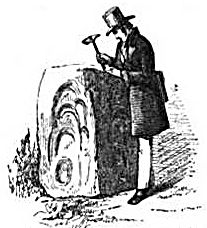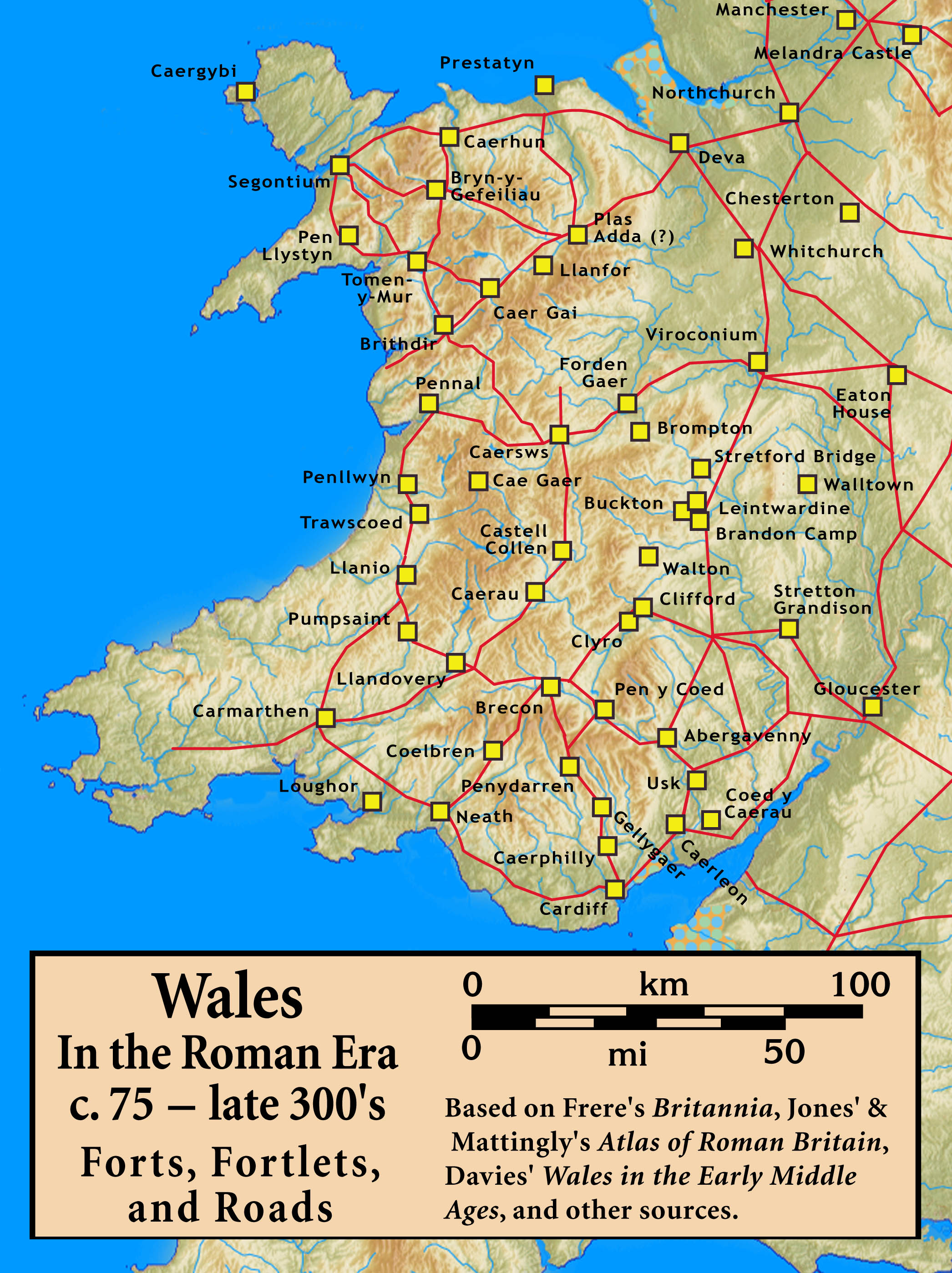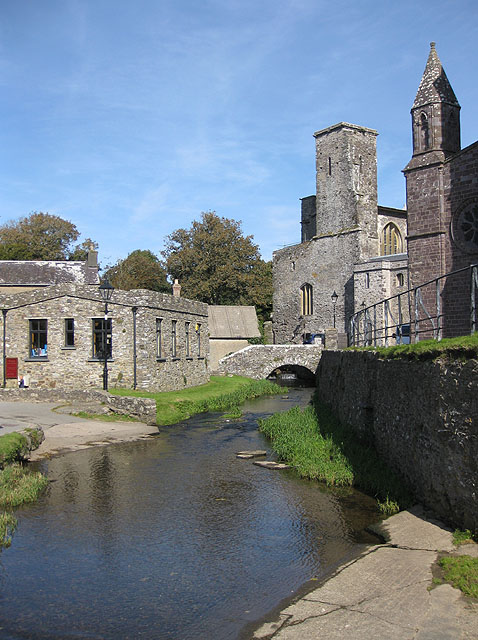|
Luentinum
Luentinum or Loventium refers to the Roman fort at Pumsaint, Carmarthenshire. The site lies either side of the A482 in Pumsaint and was in use from the mid 70s AD to around 120 AD. It may have had particular functions associated with the adjacent Dolaucothi Gold Mines. It formed part of a network of at least 30 forts across Wales, such as Llandovery, Bremia/Llanio near Llanddewi Brefi, and the fort at Llandeilo. The Roman road Sarn Helen, which runs past the Llanio and Llandovery forts was nearby. __NOTOC__ The name Luentinum is mentioned in Ptolemy's , 2nd century AD 'Geography', and is thought to relate to washing in reference to the Pumsaint gold mines. The fort appears to have been founded as a square 5½ acre (2.25 hectare) Roman auxiliary fort controlling the adjoining gold mines, around AD 75 when Frontinus was governor of Roman Britain and active in subduing the Silures of Roman Wales. The fort had an earthen rampart and double ditch. The date of first construction was d ... [...More Info...] [...Related Items...] OR: [Wikipedia] [Google] [Baidu] |
Pumsaint
Pumsaint is a village in Carmarthenshire, Wales, halfway between Llanwrda and Lampeter on the A482 in the valley of the Afon Cothi. It forms part of the extensive estate of Dolaucothi, which is owned by the National Trust. The name is Welsh for "Five Saints" (''Pump'' being the word for "five"). The name is derived from the stone block at the nearby gold mines, opposite Ogofau Lodge, which has four sides, each of which has hollows probably caused by pestle impacts. It was used as an anvil for crushing gold ore in the Roman period. Excavations in the 1990s of the area adjacent to the stone showed that the stone was originally horizontal and used as an anvil for a water-powered crushing mill. There are many parallels from Spanish mines of the Roman period with similar stone anvils. Places of interest The nearby conservation area has several scheduled ancient monuments including the Dolaucothi Gold Mines. Archaeologists have uncovered evidence of Roman occupation of the area, i ... [...More Info...] [...Related Items...] OR: [Wikipedia] [Google] [Baidu] |
Wales In The Roman Era
The Roman era in the area of modern Wales began in 48 AD, with a military invasion by the imperial governor of Roman Britain. The conquest was completed by 78 AD, and Roman rule endured until the region was abandoned in 383 AD. The Roman Empire held a military occupation in most of Wales, except for the southern coastal region of South Wales, east of the Gower Peninsula, where there is a legacy of Romanisation in the region, and some southern sites such as Carmarthen, which was the civitas capital of the Demetae tribe. The only town in Wales founded by the Romans, Caerwent, is located in South Wales. Wales was a rich source of mineral wealth, and the Romans used their engineering technology to extract large amounts of gold, copper, and lead, as well as modest amounts of some other metals such as zinc and silver. The Roman campaigns of conquest in Wales appear in surviving ancient sources, who record in particular the resistance and ultimate conquest of two of the ... [...More Info...] [...Related Items...] OR: [Wikipedia] [Google] [Baidu] |
Sarn Helen
Sarn Helen refers to several stretches of Roman road in Wales. The route, which follows a meandering course through central Wales, connects Aberconwy in the north with Carmarthen in the west. Despite its length, academic debate continues as to the precise course of the Roman road. Many sections are now used by the modern road network while other parts are still traceable. However, there are sizeable stretches that have been lost and are unidentifiable. The route is named after Saint Elen of Caernarfon, a Celtic saint, whose story is told in ''The Dream of Macsen Wledig'', part of the ''Mabinogion''. She is said to have ordered the construction of roads in Wales during the late 4th century. Route Aberconwy–Carmarthen In the north the route is believed to follow the western bank of the river Conwy from Canovium, a fort at Caerhun, passing through Trefriw, then leading on to Betws-y-Coed, with a branch leading to Caer Llugwy near Capel Curig. The route then passed through ... [...More Info...] [...Related Items...] OR: [Wikipedia] [Google] [Baidu] |
Dolaucothi Gold Mines
The Dolaucothi Gold Mines (; cy, Mwynfeydd Aur Dolaucothi) (), also known as the Ogofau Gold Mine, are ancient Roman surface and underground mines located in the valley of the River Cothi, near Pumsaint, Carmarthenshire, Wales. The gold mines are located within the Dolaucothi Estate which is now owned by the National Trust. They are the only mines for Welsh gold outside those of the Dolgellau gold-belt, and are a Scheduled Ancient Monument. They are also the only known Roman gold mines in Britain, although it does not exclude the likelihood that they exploited other known sources in Devon in South West England, north Wales, Scotland and elsewhere. The site is important for showing advanced Roman technology. Roman mining methods Archaeology suggests that gold extraction on this site may have started sometime in the Bronze Age, possibly by washing of the gold-bearing gravels of the river Cothi, the most elementary type of gold prospecting. Sextus Julius Frontinus was ... [...More Info...] [...Related Items...] OR: [Wikipedia] [Google] [Baidu] |
Hushing
Hushing is an ancient and historic mining method using a flood or torrent of water to reveal mineral veins. The method was applied in several ways, both in prospecting for ores, and for their exploitation. Mineral veins are often hidden below soil and sub-soil, which must be stripped away to discover the ore veins. A flood of water is very effective in moving soil as well as working the ore deposits when combined with other methods such as fire-setting. Hushing was used during the formation and expansion of the Roman Empire from the 1st century BC on to the end of the empire. It was also widely used later, and apparently survived until modern times where the cost of explosives was prohibitive. It was widely used in the United States, where it was known as "booming". A variant known as hydraulic mining where jets or streams of water are used to break down deposits, especially of alluvial gold and alluvial tin, is commonly used. History The method is well described by Pliny ... [...More Info...] [...Related Items...] OR: [Wikipedia] [Google] [Baidu] |
National Museum Of Wales
National may refer to: Common uses * Nation or country ** Nationality – a ''national'' is a person who is subject to a nation, regardless of whether the person has full rights as a citizen Places in the United States * National, Maryland, census-designated place * National, Nevada, ghost town * National, Utah, ghost town * National, West Virginia, unincorporated community Commerce * National (brand), a brand name of electronic goods from Panasonic * National Benzole (or simply known as National), former petrol station chain in the UK, merged with BP * National Car Rental, an American rental car company * National Energy Systems, a former name of Eco Marine Power * National Entertainment Commission, a former name of the Media Rating Council * National Motor Vehicle Company, Indianapolis, Indiana, USA 1900-1924 * National Supermarkets, a defunct American grocery store chain * National String Instrument Corporation, a guitar company formed to manufacture the first resonator ... [...More Info...] [...Related Items...] OR: [Wikipedia] [Google] [Baidu] |
British Language (Celtic)
Common Brittonic ( cy, Brythoneg; kw, Brythonek; br, Predeneg), also known as British, Common Brythonic, or Proto-Brittonic, was a Celtic language spoken in Britain and Brittany. It is a form of Insular Celtic, descended from Proto-Celtic, a theorized parent tongue that, by the first half of the first millennium BC, was diverging into separate dialects or languages. Pictish is linked, likely as a sister language or a descendant branch. Evidence from early and modern Welsh shows that Common Brittonic took a significant amount of influence from Latin during the Roman period, especially in terms related to the church and Christianity. By the sixth century AD, the tongues of the Celtic Britons were more rapidly splitting into Neo-Brittonic: Welsh, Cumbric, Cornish, Breton, and possibly the Pictish language. Over the next three centuries it was replaced in most of Scotland by Scottish Gaelic and by Old English (from which descend Modern English and Scots) throughout most ... [...More Info...] [...Related Items...] OR: [Wikipedia] [Google] [Baidu] |
Geographia (Ptolemy)
The ''Geography'' ( grc-gre, Γεωγραφικὴ Ὑφήγησις, ''Geōgraphikḕ Hyphḗgēsis'', "Geographical Guidance"), also known by its Latin names as the ' and the ', is a gazetteer, an atlas, and a treatise on cartography, compiling the geographical knowledge of the 2nd-century Roman Empire. Originally written by Claudius Ptolemy in Greek at Alexandria around AD 150, the work was a revision of a now-lost atlas by Marinus of Tyre using additional Roman and Persian gazetteers and new principles. Its translation into Arabic in the 9th century and Latin in 1406 was highly influential on the geographical knowledge and cartographic traditions of the medieval Caliphate and Renaissance Europe. Manuscripts Versions of Ptolemy's work in antiquity were probably proper atlases with attached maps, although some scholars believe that the references to maps in the text were later additions. No Greek manuscript of the ''Geography'' survives from earlier than the 13th c ... [...More Info...] [...Related Items...] OR: [Wikipedia] [Google] [Baidu] |
Hydraulic Mining
Hydraulic mining is a form of mining that uses high-pressure jets of water to dislodge rock material or move sediment.Paul W. Thrush, ''A Dictionary of Mining, Mineral, and Related Terms'', US Bureau of Mines, 1968, p.560. In the placer mining of gold or tin, the resulting water-sediment slurry is directed through sluice boxes to remove the gold. It is also used in mining kaolin and coal. Hydraulic mining developed from ancient Roman techniques that used water to excavate soft underground deposits. Its modern form, using pressurized water jets produced by a nozzle called a "monitor", came about in the 1850s during the California Gold Rush in the United States. Though successful in extracting gold-rich minerals, the widespread use of the process resulted in extensive environmental damage, such as increased flooding and erosion, and sediment blocking waterways and covering farm fields. These problems led to its legal regulation. Hydraulic mining has been used in various forms arou ... [...More Info...] [...Related Items...] OR: [Wikipedia] [Google] [Baidu] |
Carmarthen
Carmarthen (, RP: ; cy, Caerfyrddin , "Merlin's fort" or "Sea-town fort") is the county town of Carmarthenshire and a community in Wales, lying on the River Towy. north of its estuary in Carmarthen Bay. The population was 14,185 in 2011, down from 15,854 in 2001, but gauged at 16,285 in 2019. It has a claim to be the oldest town in Wales – ''Old Carmarthen'' and ''New Carmarthen'' became one borough in 1546. It was the most populous borough in Wales in the 16th–18th centuries, described by William Camden as "chief citie of the country". Growth stagnated by the mid-19th century as new settlements developed in the South Wales Coalfield. History Early history When Britannia was a Roman province, Carmarthen was the civitas capital of the Demetae tribe, known as Moridunum ("Sea Fort"). It is possibly the oldest town in Wales, recorded by Ptolemy and in the Antonine Itinerary. The Roman fort is believed to date from about AD 75. A Roman coin hoard was found nearby in 2 ... [...More Info...] [...Related Items...] OR: [Wikipedia] [Google] [Baidu] |
St David's
St Davids or St David's ( cy, Tyddewi, , "David's house”) is a city and a community (named St Davids and the Cathedral Close) with a cathedral in Pembrokeshire, Wales, lying on the River Alun. It is the resting place of Saint David, Wales's patron saint, and named after him. St Davids is the United Kingdom's smallest city in population (just over 1,600 in 2011) and urban area (the smallest city by local authority boundary area being the City of London). St Davids was given city status in the 12th century. This does not derive automatically from criteria, but in England and Wales it was traditionally given to cathedral towns under practices laid down in the early 1540s, when Henry VIII founded dioceses. City status was lost in 1886, but restored in 1994 at the request of Queen Elizabeth II. History Early history Although the surrounding landscape is home to a number of Palaeolithic, Bronze Age and Iron Age sites, archaeological evidence suggests that Pembrokeshire was ... [...More Info...] [...Related Items...] OR: [Wikipedia] [Google] [Baidu] |
Roman Road
Roman roads ( la, viae Romanae ; singular: ; meaning "Roman way") were physical infrastructure vital to the maintenance and development of the Roman state, and were built from about 300 BC through the expansion and consolidation of the Roman Republic and the Roman Empire. They provided efficient means for the overland movement of armies, officials, civilians, inland carriage of official communications, and trade goods. Roman roads were of several kinds, ranging from small local roads to broad, long-distance highways built to connect cities, major towns and military bases. These major roads were often stone-paved and metaled, cambered for drainage, and were flanked by footpaths, bridleways and drainage ditches. They were laid along accurately surveyed courses, and some were cut through hills, or conducted over rivers and ravines on bridgework. Sections could be supported over marshy ground on rafted or piled foundations.Corbishley, Mike: "The Roman World", page 50. Warwick Pr ... [...More Info...] [...Related Items...] OR: [Wikipedia] [Google] [Baidu] |









